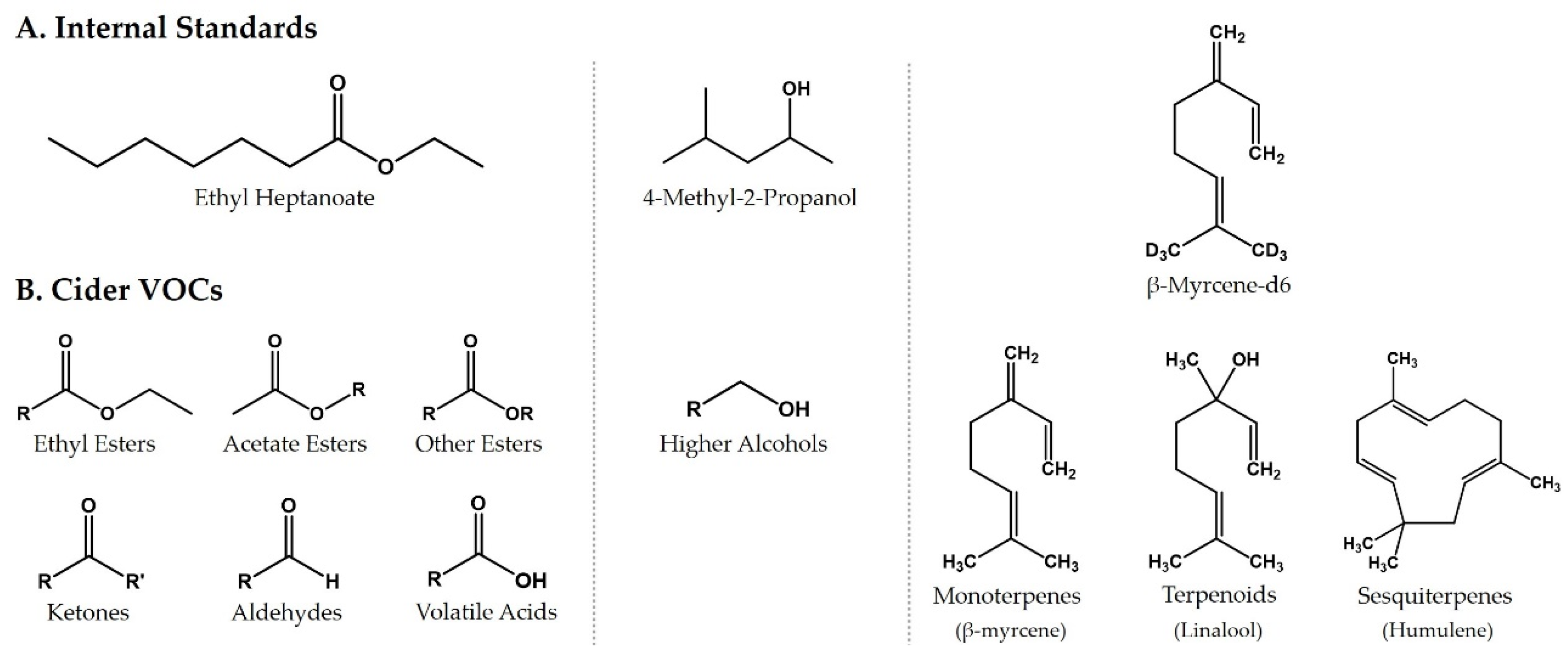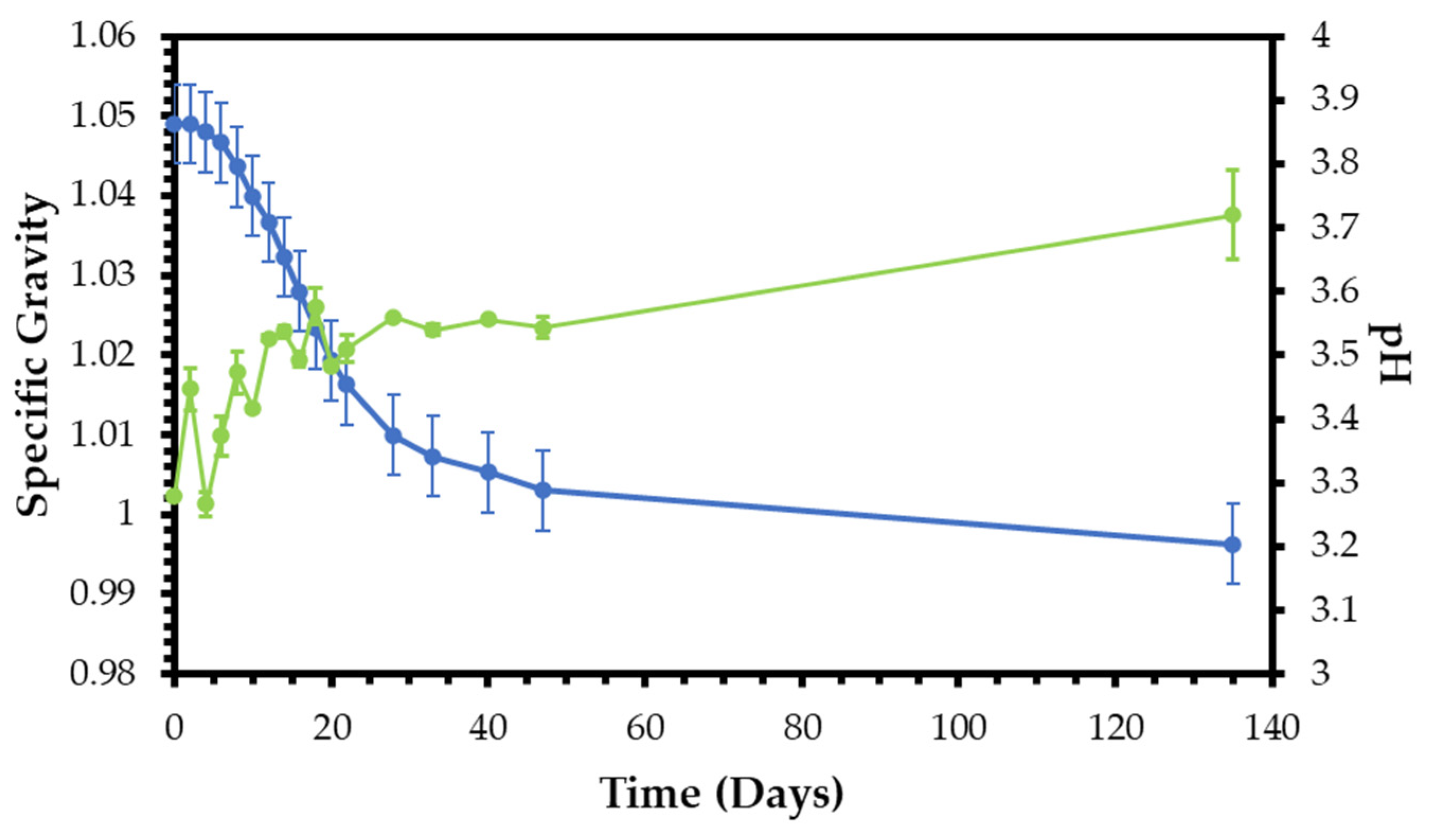Aroma Profiles of Dry-Hopped Ciders Produced with Citra, Galaxy, and Mosaic Hops
Abstract
:1. Introduction
2. Materials and Methods
2.1. Apple Fruit Collection
2.2. Apple Fruit Processing and Juice Analysis
2.3. Fermentation
2.4. Dry Hopping
2.5. Headspace–Solid Phase Microextraction (HS–SPME)
2.6. Gas Chromatography—Mass Spectrometry (GC-MS) Analysis
3. Results and Discussion
3.1. Fermentation Monitoring
3.2. Higher Alcohol and Ester Analysis
| (a) | |||||||
| Juice | Day 2 | Day 12 | Day 22 | ||||
| Higher Alcohols | RT (min) | Concentration a | Concentration | Concentration | Concentration | Odor Descriptor | PT (mg L–1) |
| 1-butanol | 2.3 | 1.920 ± 0.286 | 3.008 ± 0.358 | 2.300 ± 0.295 | 1.767 ± 0.021 | Medicinal b | 150 b |
| 1-pentanol b | 3.0 | 3.070 ± 0.723 | 5.452 ± 0.934 | 25.477 ± 1.275 | 49.65 ± 1.367 | Alcohol, fruity c | 0.030–45 c |
| 1-hexanol | 6.6 | 40.533 ± 6.665 | 92.153 ± 1.417 | 53.733 ± 3.387 | 49.433 ± 1.037 | Flower, green e | 8 d |
| 2-phenylethanol | 17.7 | - | - | 6.500 ± 1.019 | 18.927 ± 9.112 | Floral, rose e | 14 d |
| Esters | |||||||
| Ethyl butanoate | 4.3 | 0.028 ± 0.017 | 0.039 ± 0.008 | 0.038 ± 0.006 | 0.031 ± 0.002 | Fruity, sweet e | 0.4 b |
| Ethyl hexanoate | 12.3 | 0.031 ± 0.018 | 0.027 ± 0.007 | 0.050 ± 0.001 | 0.224 ± 0.021 | Fruity, apple e | 0.014 d |
| Hexyl acetate | 12.9 | - | - | 0.612 ± 0.121 | 0.763 ± 0.050 | Fruity, herb e | 0.67 b |
| Ethyl octanoate | 22.0 | - | 0.057 ± 0.005 | 0.146 ± 0.029 | 0.440 ± 0.091 | Fruity, fatty e | 0.005 d |
| Ethyl decanoate | 30.8 | - | - | 0.044 ± 0.013 | 0.170 ± 0.094 | Fruity, grape b,e | 0.2 b |
| (b) | |||||||
| Day 28 | Day 40 | Day 47 | Day 135 | ||||
| Higher Alcohols | RT (min) | Concentration a | Concentration | Concentration | Concentration | Odor Descriptor | PT (mg L–1) |
| 1-butanol | 2.3 | 2.030 ± 0.135 | 1.953 ± 0.132 | 2.870 ± 0.305 | 0.930 ± 0.268 | Medicinal b | 150 b |
| 1-pentanol b | 3.0 | 57.923 ± 1.207 | 57.350 ± 1.084 | 71.967 ± 2.764 | 75.452 ± 7.844 | Alcohol, fruity c | 0.030–45 c |
| 1-hexanol | 6.6 | 49.100 ± 1.037 | 43.167 ± 4.691 | 40.267 ± 2.301 | 43.633 ± 1.584 | Flower, green e | 8 d |
| 2-phenylethanol | 17.7 | 21.670 ± 4.229 | 17.000 ± 6.318 | 22.700 ± 6.239 | 22.857 ± 19.067 | Floral, rose e | 14 d |
| Esters | |||||||
| Ethyl butanoate | 4.3 | 0.021 ± 0.011 | 0.012 ± 0.002 | 0.013 ± 0.003 | 0.020 ± 0.003 | Fruity, sweet e | 0.4 b |
| Ethyl hexanoate | 12.3 | 0.218 ± 0.078 | 0.157 ± 0.025 | 0.149 ± 0.034 | 0.270 ± 0.028 | Fruity, apple e | 0.014 d |
| Hexyl acetate | 12.9 | 0.534 ± 0.161 | 0.302 ± 0.043 | 0.251 ± 0.060 | 0.430 ± 0.068 | Fruity, herb e | 0.67 b |
| Ethyl octanoate | 22.0 | 0.550 ± 0.124 | 0.365 ± 0.032 | 0.403 ± 0.061 | 1.230 ± 0.229 | Fruity, fatty e | 0.005 d |
| Ethyl decanoate | 30.8 | 0.239 ± 0.018 | 0.069 ± 0.001 | 0.079 ± 0.023 | 0.270 ± 0.102 | Fruity, grape b,e | 0.2 b |
3.3. Dry-Hopped Cider Analysis
4. Conclusions
Supplementary Materials
Author Contributions
Funding
Data Availability Statement
Acknowledgments
Conflicts of Interest
References
- Miles, C.A.; Alexander, T.R.; Peck, G.; Galinato, S.P.; Gottschalk, C.; Van Nocker, S. Growing Apples for Hard Cider Production in the United States—Trends and Research Opportunities. HortTechnology 2020, 30, 148–155. [Google Scholar] [CrossRef]
- Watson, B. 2020 Points and 2021 Predictions. Available online: https://www.brewersassociation.org/insights/2020-points-and-2021-predictions/ (accessed on 25 June 2021).
- Schuenemeyer, A.; Schuenemeyer, J. Montezuma Orchard Resoration Project. Available online: https://montezumaorchard.org/ (accessed on 24 May 2021).
- Lafontaine, S.R.; Shellhammer, T.H. Impact of static dry-hopping rate on the sensory and analytical profiles of beer. J. Inst. Brew. 2018, 124, 434–442. [Google Scholar] [CrossRef] [Green Version]
- Miles, C.A.; King, J.; Alexander, T.; Scheenstra, E. Evaluation of Flower, Fruit, and Juice Characteristics of a Multinational Collection of Cider Apple Cultivars Grown in the U.S. Pacific Northwest. HortTechnology 2017, 27, 431–439. [Google Scholar] [CrossRef] [Green Version]
- Brendel, S.; Hofmann, T.; Granvogl, M. Dry-Hopping to Modify the Aroma of Alcohol-Free Beer on a Molecular Level—Loss and Transfer of Odor-Active Compounds. J. Agric. Food Chem. 2020, 68, 8602–8612. [Google Scholar] [CrossRef] [PubMed]
- Duarte, L.M.; Amorim, T.L.; Grazul, R.M.; de Oliveira, M.A.L. Differentiation of aromatic, bittering and dual-purpose commercial hops from their terpenic profiles: An approach involving batch extraction, GC–MS and multivariate analysis. Food Res. Int. 2020, 138, 109768. [Google Scholar] [CrossRef] [PubMed]
- Van Opstaele, F.; De Causmaecker, B.; Aerts, G.; De Cooman, L. Characterization of Novel Varietal Floral Hop Aromas by Headspace Solid Phase Microextraction and Gas Chromatography–Mass Spectrometry/Olfactometry. J. Agric. Food Chem. 2012, 60, 12270–12281. [Google Scholar] [CrossRef]
- Rettberg, N.; Biendl, M.; Garbe, L.-A. Hop Aroma and Hoppy Beer Flavor: Chemical Backgrounds and Analytical Tools—A Review. J. Am. Soc. Brew. Chem. 2018, 76, 1–20. [Google Scholar] [CrossRef]
- Werrie, P.-Y.; Deckers, S.; Fauconnier, M.-L. Brief Insight into the Underestimated Role of Hop Amylases on Beer Aroma Profiles. J. Am. Soc. Brew. Chem. 2021, 1–9. [Google Scholar] [CrossRef]
- Bingman, M.T.; Stellick, C.E.; Pelkey, J.P.; Scott, J.M.; Cole, C.A. Monitoring Cider Aroma Development throughout the Fermentation Process by Headspace Solid Phase Microextraction (HS-SPME) Gas Chromatography–Mass Spectrometry (GC-MS) Analysis. Beverages 2020, 6, 40. [Google Scholar] [CrossRef]
- Perestrelo, R.; Silva, C.L.; da Silva, P.M.C.; Medina, S.; Pereira, R.; Câmara, J.S. Untargeted fingerprinting of cider volatiles from different geographical regions by HS-SPME/GC-MS. Microchem. J. 2019, 148, 643–651. [Google Scholar] [CrossRef]
- Nešpor, J.; Karabín, M.; Štulíková, K.; Dostálek, P. An HS-SPME-GC-MS Method for Profiling Volatile Compounds as Related to Technology Used in Cider Production. Molecules 2019, 24, 2117. [Google Scholar] [CrossRef] [PubMed] [Green Version]
- Englezos, V.; Torchio, F.; Cravero, F.; Marengo, F.; Giacosa, S.; Gerbi, V.; Rantsiou, K.; Rolle, L.; Cocolin, L. Aroma profile and composition of Barbera wines obtained by mixed fermentations of Starmerella bacillaris (synonym Candida zemplinina) and Saccharomyces cerevisiae. LWT 2016, 73, 567–575. [Google Scholar] [CrossRef]
- Wei, J.; Zhang, Y.; Qiu, Y.; Guo, H.; Ju, H.; Wang, Y.; Yuan, Y.; Yue, T. Chemical composition, sensorial properties, and aroma-active compounds of ciders fermented with Hanseniaspora osmophila and Torulaspora quercuum in co- and sequential fermentations. Food Chem. 2020, 306, 125623. [Google Scholar] [CrossRef]
- Ochiai, N.; Sasamoto, K.; Kishimoto, T. Development of a Method for the Quantitation of Three Thiols in Beer, Hop, and Wort Samples by Stir Bar Sorptive Extraction with in Situ Derivatization and Thermal Desorption–Gas Chromatography–Tandem Mass Spectrometry. J. Agric. Food Chem. 2015, 63, 6698–6706. [Google Scholar] [CrossRef] [PubMed]
- Schuenemeyer, A.; Schuenemeyer, J. Montezuma Orchard Restoration Project Map. Available online: https://morp-acp.maps.arcgis.com/apps/webappviewer/index.html?id=91f531fb0d9843fab5d7455c15addefd&extent=-12208863.2258%2C4278369.2786%2C-11132629.8676%2C5105112.1766%2C102100 (accessed on 24 May 2021).
- ASBC. ASBC Methods of Analysis, 14th ed.; ASBC: St. Paul, MN, USA, 2011. [Google Scholar]
- Herrero, M.; García, L.A.; Díaz, M. Volatile Compounds in Cider: Inoculation Time and Fermentation Temperature Effects. J. Inst. Brew. 2006, 112, 210–214. [Google Scholar] [CrossRef]
- Dennenlöhr, J.; Thörner, S.; Manowski, A.; Rettberg, N. Analysis of Selected Hop Aroma Compounds in Commercial Lager and Craft Beers Using HS-SPME-GC-MS/MS. J. Am. Soc. Brew. Chem. 2019, 78, 16–31. [Google Scholar] [CrossRef]
- Curran, A.M.; Rabin, S.I.; Prada, P.A.; Furton, K.G. Comparison of the Volatile Organic Compounds Present in Human Odor Using Spme-GC/MS. J. Chem. Ecol. 2005, 31, 1607–1619. [Google Scholar] [CrossRef]
- Akin, H.; Brandam, C.; Meyer, X.-M.; Strehaiano, P. A model for pH determination during alcoholic fermentation of a grape must by Saccharomyces cerevisiae. Chem. Eng. Process. Process. Intensif. 2008, 47, 1986–1993. [Google Scholar] [CrossRef] [Green Version]
- Miyazawa, M.; Nagata, T.; Nakahashi, H.; Takahashi, T. Characteristic odor components of essential oil from Caesalpinia decapetala. J. Essent. Oil Res. 2012, 24, 441–446. [Google Scholar] [CrossRef]
- He, W.; Liu, S.; Heponiemi, P.; Heinonen, M.; Marsol-Vall, A.; Ma, X.; Yang, B.; Laaksonen, O. Effect of Saccharomyces cerevisiae and Schizosaccharomyces pombe strains on chemical composition and sensory quality of ciders made from Finnish apple cultivars. Food Chem. 2021, 345, 128833. [Google Scholar] [CrossRef]
- Antón-Díaz, M.J.; Valles, B.S.; Hevia, A.G.; Lobo, A.P. Aromatic Profile of Ciders by Chemical Quantitative, Gas Chromatography-Olfactometry, and Sensory Analysis. J. Food Sci. 2014, 79, S92–S99. [Google Scholar] [CrossRef]
- Arcari, S.; Caliari, V.; Sganzerla, M.; Godoy, H.T. Volatile composition of Merlot red wine and its contribution to the aroma: Optimization and validation of analytical method. Talanta 2017, 174, 752–766. [Google Scholar] [CrossRef]
- Yu, H.; Xie, T.; Xie, J.; Chen, C.; Ai, L.; Tian, H. Aroma perceptual interactions of benzaldehyde, furfural, and vanillin and their effects on the descriptor intensities of Huangjiu. Food Res. Int. 2020, 129, 108808. [Google Scholar] [CrossRef]
- Tura, D.; Failla, O.; Bassi, D.; Pedò, S.; Serraiocco, A. Cultivar influence on virgin olive (Olea europea L.) oil flavor based on aromatic compounds and sensorial profile. Sci. Hortic. 2008, 118, 139–148. [Google Scholar] [CrossRef]
- Escudero, A.; Gogorza, B.; Melús, M.A.; Ortín, N.; Cacho, A.J.; Ferreira, V. Characterization of the Aroma of a Wine from Maccabeo. Key Role Played by Compounds with Low Odor Activity Values. J. Agric. Food Chem. 2004, 52, 3516–3524. [Google Scholar] [CrossRef] [PubMed]
- Aparicio, R.; Morales, M.T. Characterization of Olive Ripeness by Green Aroma Compounds of Virgin Olive Oil. J. Agric. Food Chem. 1998, 46, 1116–1122. [Google Scholar] [CrossRef]
- Wijaya, C.H.; Hadiprodjo, I.T.; Apriyantono, A. Identification of Volatile Compounds and Key Aroma Compounds of Andaliman Fruit (Zanthoxylum Acanthopodium DC.). Food Sci. Biotechnol. 2002, 2, 680–683. [Google Scholar]
- Pino, J.A.; Trujillo, R. Characterization of odour-active compounds of sour guava (Psidium acidum [DC.]Landrum) fruit by gas chromatography-olfactometry and odour activity value. Flavour Fragr. J. 2021, 36, 207–212. [Google Scholar] [CrossRef]





Publisher’s Note: MDPI stays neutral with regard to jurisdictional claims in published maps and institutional affiliations. |
© 2021 by the authors. Licensee MDPI, Basel, Switzerland. This article is an open access article distributed under the terms and conditions of the Creative Commons Attribution (CC BY) license (https://creativecommons.org/licenses/by/4.0/).
Share and Cite
Bingman, M.T.; Hinkley, J.L.; Bradley, C.P., II; Cole, C.A. Aroma Profiles of Dry-Hopped Ciders Produced with Citra, Galaxy, and Mosaic Hops. Appl. Sci. 2022, 12, 310. https://doi.org/10.3390/app12010310
Bingman MT, Hinkley JL, Bradley CP II, Cole CA. Aroma Profiles of Dry-Hopped Ciders Produced with Citra, Galaxy, and Mosaic Hops. Applied Sciences. 2022; 12(1):310. https://doi.org/10.3390/app12010310
Chicago/Turabian StyleBingman, Matthew T., Josephine L. Hinkley, Colin P. Bradley, II, and Callie A. Cole. 2022. "Aroma Profiles of Dry-Hopped Ciders Produced with Citra, Galaxy, and Mosaic Hops" Applied Sciences 12, no. 1: 310. https://doi.org/10.3390/app12010310





